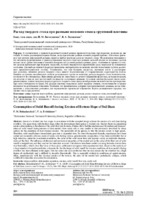| dc.contributor.author | Богославчик, П. М. | |
| dc.contributor.author | Евдокимов, В. А. | |
| dc.coverage.spatial | Минск | ru |
| dc.date.accessioned | 2020-10-02T09:20:39Z | |
| dc.date.available | 2020-10-02T09:20:39Z | |
| dc.date.issued | 2020 | |
| dc.identifier.citation | Богославчик, П. М. Расход твердого стока при размыве низового откоса грунтовой плотины = Consumption of Solid Runoff during Erosion of Bottom Slope of Soil Dam / П. М. Богославчик, В. А. Евдокимов // Наука и техника. – 2020. – № 5. – С. 384-388. | ru |
| dc.identifier.uri | https://rep.bntu.by/handle/data/79690 | |
| dc.description.abstract | В соответствии с принятой расчетной схемой размыв грунтовой плотины при переливе разделен на две стадии. В статье рассмотрена первая стадия, когда происходит размыв низовой упорной призмы. Ключевым фактором при расчете деформаций размыва является выбор формулы расхода твердого стока. Исследования показывают, что механизм формирования и транспортирования твердого стока при размыве моделей плотин из песчаных грунтов весьма схож с ранее описанным многими авторами для условий размыва речных русел. Особенность процесса в том, что размыв происходит при больших скоростях, поэтому твердый сток практически сразу переходит во взвешенное состояние. Для выбора искомой формулы проведены эксперименты на моделях плотин из песчаных грунтов различного гранулометрического состава. Установлено, что при больших скоростях, имеющих место в рассмотренных условиях, значение расхода твердого стока зависит исключительно от гидравлических характеристик потока. Влияние же физико-механических свойств размываемого грунта на величину расхода твердого стока незначительно, и они могут не учитываться. Выполнены расчеты по известным из речной гидравлики формулам, которые показали, что ни одна из них не дает достаточной сходимости с опытными данными. На основе анализа большого числа экспериментальных данных получена формула расхода твердого стока для условий размыва моделей плотин при переливе. При этом учитывался тот факт, что размыв плотины переливом имеет высокую степень стохастичности и трудно поддается теоретическому описанию. Особенно это проявляется в условиях пространственного размыва, когда одновременно с классическим размывом дна периодически происходит обрушение бортов размываемого прорана, что трудно учесть при расчетах. | ru |
| dc.language.iso | ru | ru |
| dc.publisher | БНТУ | ru |
| dc.title | Расход твердого стока при размыве низового откоса грунтовой плотины | ru |
| dc.title.alternative | Consumption of Solid Runoff during Erosion of Bottom Slope of Soil Dam | ru |
| dc.type | Article | ru |
| dc.identifier.doi | 10.21122/2227-1031-2020-19-5-384-388 | |
| local.description.annotation | Erosion is divided into two stages in accordance with the accepted design scheme for erosion of a soil dam during overflow. The paper deals with the first stage, when the downstream thrust prism is washed out. The key factor in calculating erosion deformations is the choice of the solid flow rate formula. Studies show that the mechanism of formation and transportation of solid runoff during erosion of dam models from sandy oils is very similar to that previously described by many authors for the condition of river channel erosion. The peculiarity of the process is that the erosion occurs at high speeds. Therefore, solid runoff almost immediately goes into a suspended state. To select the required formula, experiments have been carried out on models of dams made of sandy soils having various granulometric composition. It has been established that at high velocities under the considered conditions, the value of the solid waste flow rate depends solely on hydraulic characteristics of the flow. The influence of physical and mechanical properties of the eroded soil on the value of the flow rate of solid runoff is insignificant, and they may not be taken into account. Calculations have been carried out using formulas known from river hydraulics, which show that none of them gives sufficient convergence with experimental data. Based on the analysis of a large number of experimental data, a formula for the discharge of solid runoff for erosion conditions of dam models during overflow has been obtained in the paper. This has taken into account the fact that the dam erosion by the overflow has a high degree of stochasticity and is difficult to describe theoretically. This is especially evident in conditions of spatial erosion, when, simultaneously with the classical erosion of the bottom, the sides of the eroded hole periodically collapse, which is difficult to take into account in the calculations. | ru |

